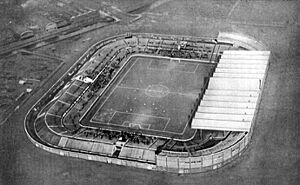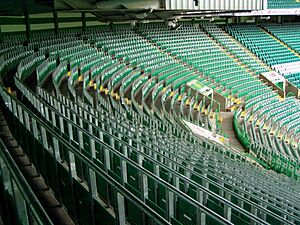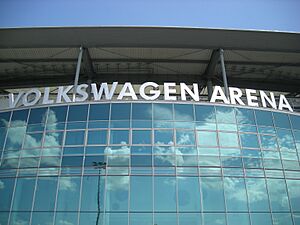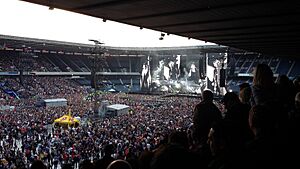Stadium facts for kids
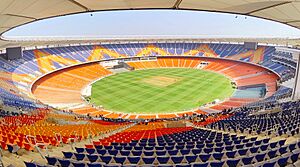
A stadium is a special place, usually outdoors, where people watch sports, concerts, or other big events. It has a field or stage in the middle, surrounded by rows of seats or standing areas for spectators. The word "stadium" comes from ancient Greece. Long ago, the only event at the ancient Olympic Games was a race that was one length of the "stadion" track.
Most stadiums that can hold at least 10,000 people are used for association football (soccer). Other popular sports played in stadiums include gridiron football, baseball, cricket, and rugby. Many large stadiums also host huge music concerts.
Contents
Where Did the Word "Stadium" Come From?
The word "stadium" comes from the Latin word for the Greek "stadion" (στάδιον). This was a unit of length, about 600 human feet long. The exact length changed a bit depending on the time and place. The Roman version, called a stadium, was similar in length. The English word "stadium" came from the tiered seating structures built around these long tracks in Roman times.
A Look Back: Stadium History
Ancient Stadiums: Where It All Began
The very first known stadium is the Stadium at Olympia in Greece. This is where the ancient Olympic Games started in 776 BC. At first, the Games only had one event: a sprint race along the stadium's track.
Ancient Greek and Roman cities had many stadiums. A famous one is the Stadium of Domitian in Rome. The ancient Panathenaic Stadium in Athens was later rebuilt. It hosted the first modern Olympic Games in 1896 and some events in the 2004 Summer Olympics.
Greek stadiums were mainly for foot races. Romans built structures called "circuses" for horse races. Both had similar shapes with seating around them. Romans also built amphitheatres, which were huge round theaters. These could hold tens of thousands of people for gladiator fights and animal shows. All these ancient structures helped inspire the modern stadiums we see today.
| Name | Country | Built around | Track length |
|---|---|---|---|
| Stadium at Olympia | Greece | 776 BC | 212.54 m (697.3 ft) |
| Stadium at Delphi | Greece | 500 BC | 177 m (581 ft) |
| Stadium of Domitian | Italy | 80 AD | 200 m (660 ft)-250 m (820 ft) (estimated) |
Modern Stadiums: From Wood to Steel

Modern stadiums first appeared when sports became very popular in the late 1800s. People wanted places to watch association football in the UK and baseball in the U.S. Early stadiums were simple, built to fit as many people as possible.
In the U.S., many early baseball stadiums were made mostly of wood. The first was the South End Grounds in Boston, opened in 1871. However, these wooden parks often caught fire or weren't big enough as the game grew. All of them were eventually replaced.
Goodison Park in England was the first stadium built specifically for association football. It opened in 1892. It had stands for thousands of fans, some covered and some open.
Architects like Archibald Leitch designed many football stadiums in England in the early 1900s. One of his famous designs was Old Trafford in Manchester. It was one of the first stadiums to have continuous seating all around the field.
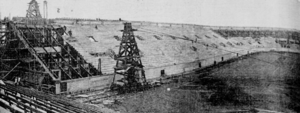
The White City Stadium in London, built for the 1908 Summer Olympics, is often called the first "modern seater" stadium in the UK. It could hold 68,000 people and had a running track and a cycle track.
In the U.S., Baker Bowl in Philadelphia was rebuilt in 1895. It was the first baseball park to use steel and brick for most of its structure. Harvard Stadium, built in 1903, was the world's first stadium to use concrete and steel. This new way of building made stadiums much stronger and safer.
The largest crowd ever at a stadium was 199,854 people. They watched the final match of the 1950 FIFA World Cup at Maracanã in Rio de Janeiro on July 16, 1950.
Different Kinds of Stadiums
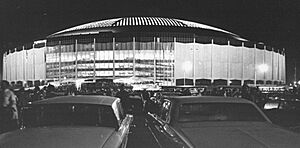
Some stadiums have roofs that cover the entire playing area. These are called domed stadiums. Many aren't shaped like a perfect dome, but the term is used for all covered stadiums. The Houston Astrodome was the first stadium to have a dome-shaped roof.
Even with a roof, these are still called stadiums because they are big and designed for sports usually played outdoors, like football or baseball. Places designed for indoor sports like basketball or hockey are usually called arenas.
Some stadiums are built for just one sport. For example, many stadiums in Europe are only for soccer. In the U.S., many are just for baseball or American football.
Multi-Purpose Stadiums
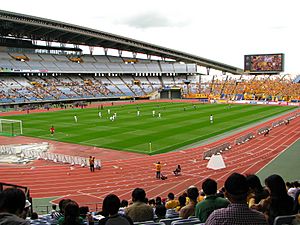
Many stadiums are designed to host different events. These are called multi-purpose stadiums. A common design combines a football field with a running track around it. The downside is that the seats are further away from the field, especially at the ends.
In North America, many stadiums were built in the 1960s to host both baseball and American football. However, these two sports need very different field shapes. So, the trend changed. Now, many cities build separate stadiums for each sport. Sometimes, a football stadium is built right next to a baseball park. This lets them share parking and other facilities.
Making Stadiums Safe and Fun
Because so many people gather in stadiums, safety is very important. Sadly, there have been accidents in the past, like the Hillsborough disaster in 1989, which caused many injuries and deaths. Since then, stadiums have made many changes to be safer. For example, in many major football matches, all spectators must be seated.
Stadiums now have separate entrances and exits for different seating areas. They also have strong walls and barriers. To prevent crime or terrorism, stadiums use video surveillance, metal detectors, and security checks. These rules help make sure stadiums are safe places for families to enjoy events together.
Who Pays for Stadiums?
Modern stadiums are huge projects that cost a lot of money. Only very large companies, wealthy people, or governments can afford them. In North America, sports teams sometimes threaten to move to another city if the government doesn't help pay for a new stadium.
In other parts of the world, like Europe, there are many football clubs in each city. This means stadiums are often built with private money. Governments also get involved when cities compete to host big events like the Summer Olympics or the FIFA World Cup. Cities often promise to build new stadiums to win these bids.
What's in a Name? Corporate Sponsors
To help pay for building and keeping up stadiums, many teams sell the rights to name their facility. This means a company pays money to have the stadium named after them. This trend started in the 1970s and became very popular in the 1990s.
Sometimes, a company name replaces an older, well-known stadium name. Other times, new stadiums are built with a corporate name from the start, like the Volkswagen Arena in Germany. This practice is now common all over the world.
One interesting thing about corporate naming is that stadium names can change. If a company changes its name or the sponsorship deal ends, the stadium might get a new name. For example, Phoenix's Chase Field used to be called Bank One Ballpark.
However, during big events like the FIFA World Cup or the Olympics, stadiums often have to use their original or a neutral name. This is because FIFA and the Olympic Committee have rules against stadium sponsors during their events. For instance, Germany's Allianz Arena was called the FIFA World Cup Stadium, Munich during the 2006 World Cup.
Stadiums and the Environment
Building modern stadiums uses a lot of materials and can increase traffic around the area. This can lead to more pollution. To help with these issues, many stadiums are now trying to be more eco-friendly. They use things like solar panels and energy-efficient lighting to reduce their impact on the environment.
Stadiums for Music Concerts
While classical music concerts have been held in stadiums for a long time, popular music started using them in the 1960s. This led to the term "stadium rock". Bands like the Beatles played at Shea Stadium in New York in 1965.
As sound systems got more powerful, more bands started playing in bigger venues. By the mid-1970s, stadium rock became popular, with bands like Queen and Kiss putting on huge shows with smoke, fireworks, and amazing lights. Since the 1980s, many famous pop and rock stars, including Madonna, Michael Jackson, Beyoncé, and Taylor Swift, have done large stadium tours.
Images for kids
-
The Circus Maximus (model pictured) was one of many circuses built in Ancient Rome.
-
The Houston Astrodome was the first domed stadium, with an enclosing roof.
-
American football–baseball multi-purpose stadiums were replaced by separate venues for the two sports, such as the Truman Sports Complex.
-
The construction of London Stadium was part of London's bid for the 2012 Summer Olympics.
See also
 In Spanish: Estadio para niños
In Spanish: Estadio para niños



